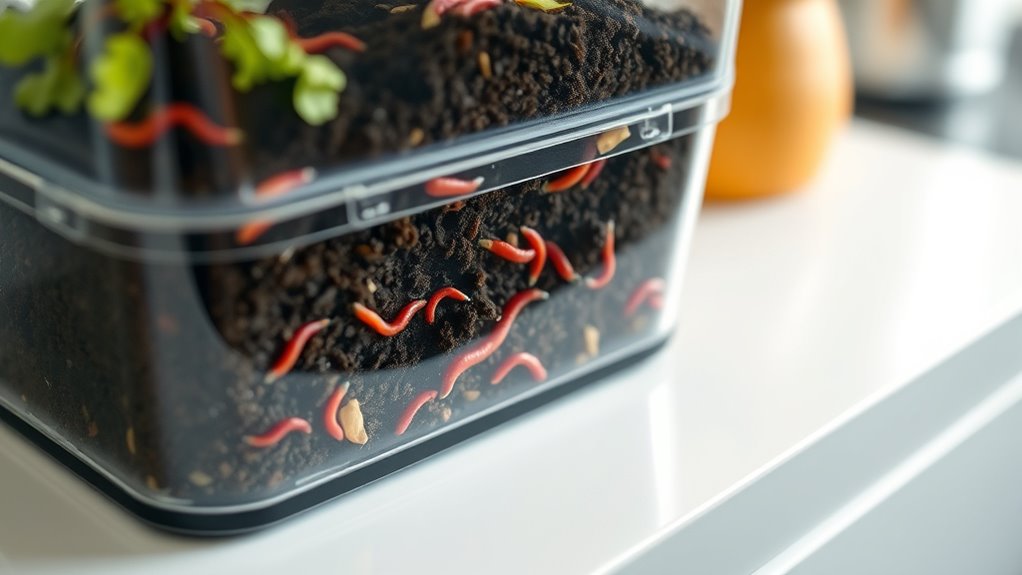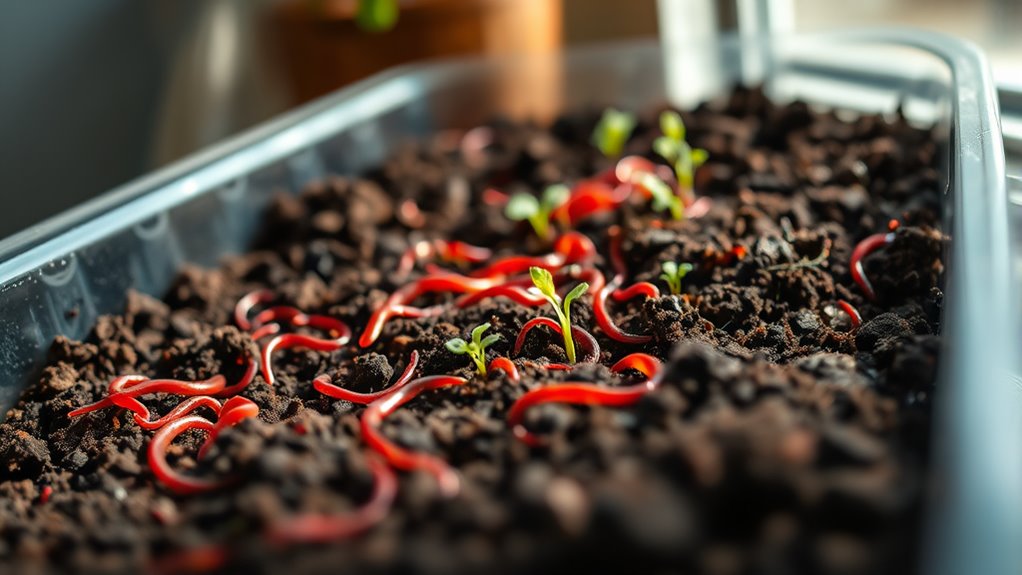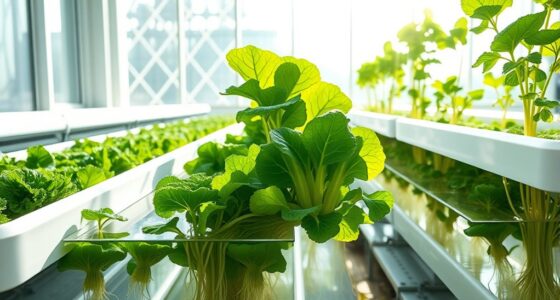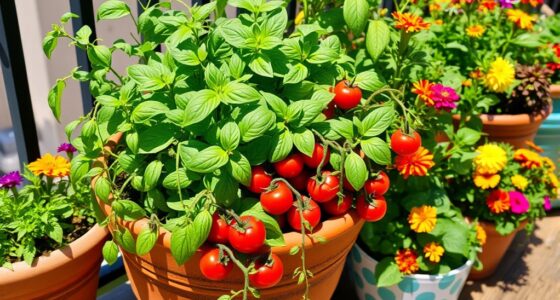Indoor vermiculture allows you to effortlessly turn kitchen scraps into nutrient-rich compost right in your city home. Using red wigglers, you can set up a compact, odor-controlled bin that’s perfect for small spaces like apartments. Keep it in a stable spot, add bedding, and feed your worms fruit, vegetable peels, or coffee grounds. With proper care, you’ll produce dark, crumbly compost for your plants, and you’ll discover more tips on maintaining an efficient system below.
Key Takeaways
- Red wigglers (Eisenia fetida) are ideal for indoor composting due to their efficiency and resilience.
- Use specialized composting bins with proper aeration, drainage, bedding, and moisture control for optimal worm habitat.
- Place the bin in a stable, shaded spot indoors, avoiding direct sunlight or extreme temperatures.
- Regularly feed kitchen scraps like fruit peels, vegetable waste, coffee grounds, and eggshells to the worms.
- Harvest rich, dark compost periodically to use as organic fertilizer for houseplants or gardens.

Have you ever wondered how to turn kitchen scraps into nutrient-rich soil effortlessly? If you’re living in a city apartment or a home with limited outdoor space, composting worms can be your best solution. Indoor vermiculture allows you to create compost right in your home using specially designed composting bins. These bins are compact, odor-controlled, and perfect for small spaces, making it easy to recycle your organic waste without any mess or smell escaping. All you need is a little bit of space and some interest in sustainable living.
Transform kitchen scraps into rich compost easily with indoor worm bins—perfect for small spaces and eco-friendly living.
One of the key factors in successful composting with worms is understanding the right worm species to use. Not all worms are suitable for composting; the most popular and effective choice is red wigglers, scientifically known as Eisenia fetida. These worms thrive in the warm, moist environment of a composting bin and are excellent at breaking down food scraps quickly. Their voracious appetite and resilience make them ideal for indoor vermiculture projects. By choosing the right worm species, you’ll ensure a fast, efficient composting process that produces rich, dark humus you can use for your houseplants or garden.
Getting started is simple. First, you’ll need to set up your composting bin, ensuring it has proper aeration and drainage. Many commercial bins are designed specifically for worm composting, with layers or sections to help separate finished compost from active bedding. Add bedding material such as shredded newspaper, cardboard, or coconut coir, and moisten it until it’s damp but not waterlogged. Then, introduce your worms, carefully placed into the bedding along with your kitchen scraps—fruit and vegetable peels, coffee grounds, eggshells, and other organic waste.
As your worms settle in, they’ll begin consuming the bedding and scraps, transforming them into nutrient-rich compost. Throughout this process, it’s important to maintain the right environment—keeping the bin in a spot with stable temperatures, avoiding direct sunlight, and monitoring moisture levels. Regularly feeding your worms and gently turning the contents will keep the composting process active and efficient. Over time, you’ll notice the bedding turning into dark, crumbly compost, which is a sign that your worms are doing their job.
Indoor vermiculture with composting bins not only reduces waste but also provides you with fresh, organic fertilizer for your plants. It’s a simple, eco-friendly way to recycle kitchen scraps and maintain a sustainable lifestyle even in the tight quarters of city living. With a little patience and care, you’ll soon be harvesting your own rich compost, all while doing your part to help the environment.
Frequently Asked Questions
What Types of Worms Are Best for Indoor Composting?
You’re wondering which worm species are best for indoor habitats. For effective composting, you should choose red wigglers, or Eisenia fetida, as they thrive in confined spaces and handle the moist, organic waste well. These worms convert kitchen scraps into nutrient-rich compost efficiently. They’re hardy, reproduce quickly, and suit indoor environments perfectly. Selecting the right worm species guarantees your indoor composting efforts are successful and low-maintenance.
How Much Compost Can One Worm Bin Produce Monthly?
Think of your worm bin as a tiny factory churning out compost. Typically, you can expect about half a pound of rich compost per week from a well-maintained bin. So, monthly, that’s roughly two pounds. Regular worm bin maintenance and a consistent composting schedule keep things running smoothly, ensuring your worms stay happy and productive. With proper care, you’ll enjoy a steady supply of nutrient-rich compost for your plants.
Are There Any Legal Restrictions for Keeping Worms Indoors?
You might wonder if there are legal restrictions on keeping worms indoors. Generally, local regulations vary, so check your city or building codes to see if permits are needed. Most urban areas don’t have strict rules for indoor vermiculture, but some places might require a permit or have specific guidelines to prevent issues like odors or pests. Always research your local regulations to guarantee you’re compliant and enjoy your composting seamlessly.
How Do I Prevent Odors From My Worm Bin?
Think of it like keeping peace in the house—you gotta stay on top of odor control. To prevent smells from your worm bin, guarantee proper bin ventilation and avoid overfeeding. Cover food scraps with bedding to absorb excess moisture and odors. Regularly stir the bedding to promote airflow, and don’t let waste pile up. These steps keep your worm bin fresh and odor-free, making indoor composting a breeze.
What Are Common Signs of a Healthy Worm Colony?
You can tell your worm colony is healthy by observing their behavior—active movement and consistent burrowing indicate vigor. Healthy worms avoid odors and are lively, often clustering near food. Regular colony maintenance, like removing excess moisture and food scraps, keeps them thriving. If your worms are wriggling actively and your bin stays odor-free, you’re on the right track. These signs show your worms are well-maintained and thriving in their environment.
Conclusion
Don’t let limited space stop you from making a difference. Indoor vermiculture with composting worms is simple, mess-free, and perfect for city homes. Some worry about odors or pests, but with proper care, your worm bin stays clean and odor-free. You’ll be surprised at how little effort it takes to reduce waste and create rich compost right in your apartment. Start today—your environment and your wallet will thank you!









